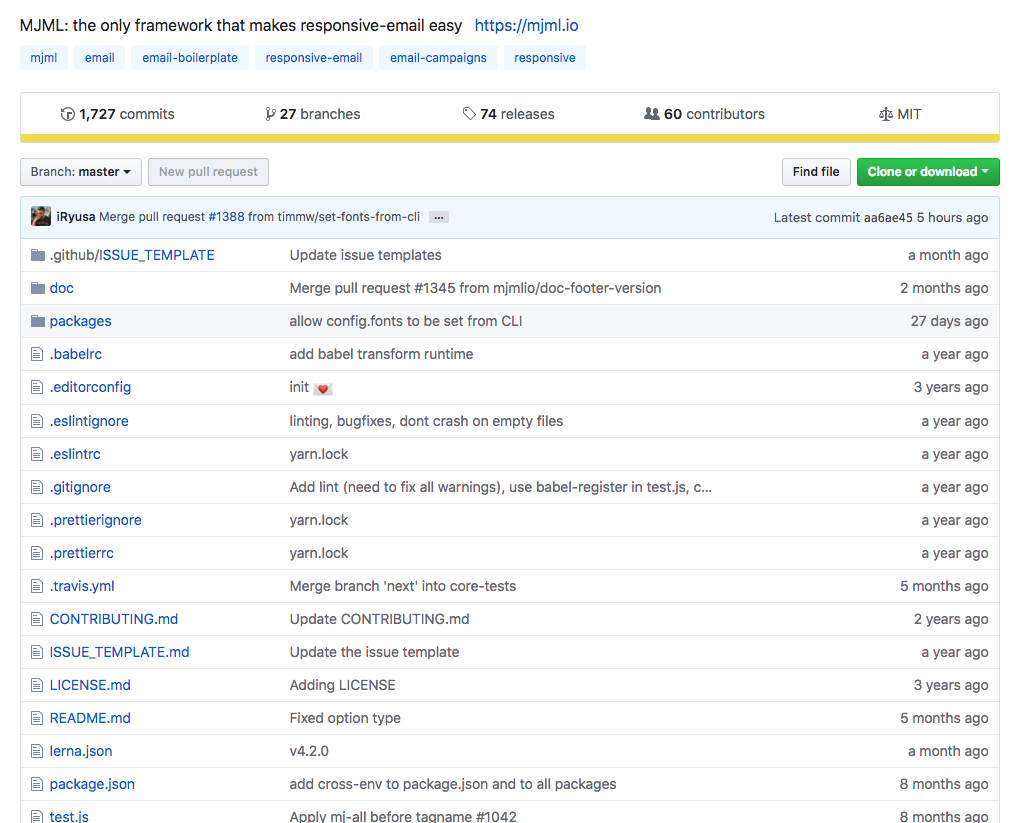Marketing
Top 5 online collaboration tools for teams
Looking for collaboration tools to use in your company? We've got your back, check out the tools we use at Mailjet and compare them.

PUBLISHED ON
One of the exciting parts about Mailjet is the fact that everyday we get to work with colleagues all around the world, from Ho Chi Minh, to Paris, to Barcelona, to Toronto (I didn’t forget you Dusseldorf, New York, Amsterdam, and London - it’s just more poetic to list 4, than all 8).
The challenge with working with teams literally all around the world, though, is ensuring we keep up to date on projects, effectively communicate, and keep our culture alive. Thankfully, we live in an age where team collaboration is baked into almost all workplace apps, and you can find some pretty incredible tools to bring the team closer together, and in the process increase your productivity.
Let’s be honest, there are countless lists out there of the best collaboration tools, often written by someone sitting behind a computer and regurgitating someone else’s ideas.
To dig a bit deeper and make it a bit more real, we thought we would survey our entire team to get an honest look at those online collaboration tools our own company uses and loves to bring their team together. This post is about the CollaborationStack™ that Mailjet uses - and would we love to hear about your own #CollaborationStack on Twitter.
Collaboration Tools at Mailjet
At Mailjet we have seven distinct teams and after surveying each team about their favorite collaboration tools, and how they use it within their team, it became very clear that each team collaborates very differently.
For this survey, our teams are Product, Customer Success, Marketing, Customer Support, Sales, Deliverability & Compliance, and Legal, HR, and Admin.
Across all teams, communication and project creation tools jumped to the top as the most loved collaboration tools. We asked teams to rate the tools they use many times each week and can say they truly love. While the Marketing team overwhelming marked Mailjet as their favorite collaboration tool (those sneaky marketers), we also wanted to dig into the rest of the #CollaborationStack.
We’ve then outlined some of the reasons behind why our team absolutely loves these tools, why they cannot live without them, and how we think teams of all sizes (whether remote or not) can take advantage of these powerful tools to bring in a deeper culture of collaboration.
Most used collaboration tools at Mailjet

Collaboration tool survey
Slack: Keeping Teams Together
How do I put this gently? Slack absolutely destroyed. Everyone at Mailjet loves Slack as not only a communications tool, but as a way to build culture across remote teams.
“Slack is great for international teams to communicate in real time. I don't know if it'd be possible to do my job in an efficient manner without it.” – Product Team
At Mailjet, we use Slack across the entire company to keep a running conversation on projects, across teams, and between colleagues. By separating teams into channels and creating private channels for specific projects, teams can quickly jump in and out of conversations to ensure they have the latest information, and can keep informed of discussions without having to be in the room.
As teams grow in size, they inherently become less connected and projects become more fragmented. Slack has become Mailjet’s primary tool to help deal with this scaling as a team, whether it’s using the live video chat for team meetings and Sandwich Lunches, using the Twitter bot to make sure we never miss a comment from our customers and partners, or sharing random images in our #wrongroom channel.

Room example in Slack
2. G Suite: Collaborate in Real Time
There really isn’t much more to say about G Suite and it’s tools Docs, Sheets, Slides and Drive, that hasn’t been said by many before. If your team isn’t using G Suite (or comparable tools like Dropbox Paper) then you’re definitely missing out on the benefits of real-time collaboration, version control, tracking changes, and more.
As with many growing companies, and especially SaaS companies like Mailjet, our team works in spurts to hammer out documents, presentations, and spreadsheets together in real-time. In fact, it is difficult to be productive in today’s working environment unless you’re working together in real time.
“I really appreciate G Suite because I can work in real-time with others from all over the world and directly see what has been added, changed or deleted.” – Customer Success Team
Gone are the days of ‘Writing a document. Saving. Closing. Attaching to an email. Then going about other business.’
Now are the days of ‘Pinging your colleagues. Jumping into a shared document. Edit together. Add comments. Resolve comments. Review. Finalize.’
According to Google, 74% of all time spent in Docs, Sheets and Slides is on collaborative work - that is, multiple people creating and editing content together.
This is certainly true for Mailjet’s documents and projects. In fact, this blog is being written in Google Docs and I can assure you that this sentence was hotly debated in the comments.
Google Docs Comments
3. Trello: Manage All Projects
Third in our rankings was Trello, the project management tool built for teams to collaborate on projects, tasks, and ideas using boards.
Mailjet uses Trello across many departments, but it’s primarily loved in our Marketing, Product, and Customer Success teams. Ultimately, the reason boils down to how simple the tool is to use, how flexible and adaptable it is across any project, and how the visual medium makes it super easy to understand and contribute to.
“I love Trello because it's at the same time really simple and really flexible to use. You can manage a team, a project, or your life!” – Marketing Team
Many people talked about how Trello can be used for not only work projects but home projects as well, whether it’s grocery lists, side projects, travel plans, or home improvement. This is increasingly true of many great collaboration tools like Slack, G Suite, and Trello, but also increasingly apps like AirBnB have launched a set of collaboration tools designed to help make travelling as a group easier.
One of our many use cases for Trello is within our Design team who use Trello to organize and prioritize design projects. Whenever we have a design need (such as a new social media image, website update, animation, or printouts) we immediately jump into Trello to lay out all the project in as much depth as possible.
As an example, if we need a new printout for an upcoming event, we can create a mockup of the design and attach it to the Trello Card, add a Google Doc with all the written content already complete, and assign a due date for the project. Our Design team then gets a notification that a new project has been added and they can ask any questions right within Trello.
Having spent the last year trying to plan design projects just within a Slack channel, our Design team was getting a little sick of the chaos. Slack is great for ongoing project conversations, but not so great for organizing single tasks - this is where Trello really fills the gap.
We’ve created a Public Trello Board for you and your Design team based on how Mailjet organizes design projects. You can access everything from the different boards we use (e.g. New Projects, In Process, and Complete),to our ReadMe card which lays out how your team can communicate projects succinctly and effectively to your Design team.
Feel free to add to it and let us know on Twitter how you think we can improve this process even more!

Trello Board Example
4. Github: Easy Version Control
Github was only used by 22% of the Mailjet team, but given Github is tailor made for developer teams, this makes sense.
Github is a cloud repository for developers to work together to host and review code, manage projects, and build software together. Similar to how G Suite solved the issue of version controls on documents, spreadsheets, and presentations, Github manages versions (or forks) of code and software, allowing teams to create new versions of code, review, comment, and eventually implement into projects.
For Mailjet, what’s most interesting about Github is actually our ability to not only collaborate internally but to also collaborate with our customers and partners. Mailjet’s Github account features projects (or more accurately, “repositories”) for plugins and other projects that are of interest to our network and need to be constantly refined. For example, our Wordpress Plugin is frequently updated due to the high interest from our network.
Users can contribute to the repository, add comments, recommend changes and so forth. This is certainly more efficient than emailing recommendations to a generic email address (e.g. contact@business.com), it brings teams together from all over to ensure our tools are beneficial and up to date for our users.
Mailjet’s MJML Github is also highly active, with 60 contributors helping build MJML as the world’s leading responsive email framework. Our Product team also keeps an active public product roadmap to keep users up to date on what is being built, when it may be released, and so forth - allowing our community to help prioritize and build the future of MJML.

Github repo
5. Mailjet: Collaborate on Email
Finally, our Marketing team has become avid users of our own collaboration toolkit at Mailjet. Our collaboration features bring everything that teams have come to love about tools like Google Docs and Trello, all within an email builder.
This includes real-time collaboration and in-app commenting, so teams can sprint on an email campaign together, all at once.
It also includes user roles and permissions so that certain members of your team can only access certain controls or sections to ensure that the best possible email is sent. For example, an intern may not have access to the design and layout, while only the Email Team Lead can ultimately push ‘Send’ on an email.
Similar to Google Docs you can also track changes and easily manage templates so that if a change was wrongfully made to a template you can easily revert back to old versions, or if you would like to apply a change to all templates (e.g. if you’ve updated your logo) you can do so with one easy click.
Ultimately, alongside each of the above tools, we use Mailjet’s collaboration features on a daily basis to create the perfect template for on-boarding new users or sending our weekly blog newsletter.
Specifically, if you subscribe to our newsletter, you will receive a rundown of important new blogs, events, webinars, and more. Each week, our team works together to ensure the copy is perfect, the design is on-brand, the A/B tests are optimized, and the links are correct. In a world where email campaigns can involve as much as 11 contributors and five iterations, we’re excited to have a tool that makes emailing as a team faster and easier (we just so happen to have been the ones to build it).
Mailjet Comments - Collaboration tool
Honorable Mentions
When we conducted our survey, the thing we noticed immediately was that collaboration was baked into almost all the tools our team uses. While Slack, G Suite, Trello, Github, and Mailjet were the most actively used and loved tools, there were a few others that our team simply couldn’t live without.
Asana
Asana was used by many across the company as another way of managing projects and tasks in a very similar way to Trello, however was particularly helpful for teams planning our projects across timelines and dates, such as a content calendar or social media schedule.
Invision
Invision is a fantastic app used by our Product and Design team to collaboratively design user experiences, apps, websites in real time.
Spendesk
Spendesk is an all-in-one business spending tool that helps finance teams collaborate better with the rest of their business. Designed to make managing expenses, reports, and tracking much easier, Spendesk is a great for large and growing teams.
Evernote
Evernote is a popular app for our team looking to keep shared notebooks and folders, particularly when planning out ideas and campaigns. For example, our Customer Success team can keep a shared notebook on stories from our customers segmented by industry, or country, or size, so there is a one-stop repository for quotes and requests from our customers.
Talkspirit
Talkspirit is an all-in-one collaborative platform, 100% made in France, designed for SMBs and mid-size companies. The platform is based on modern collaborative features (videoconferencing, chat, collaborative office suite, task assignment, groups/communities...) to facilitate sharing and accessing information, and to make collaborative work more enjoyable and productive.
We've told you what our favourite tools are and how our teams use them. The lesson here is that collaboration is increasingly at the heart of the tools we use in our modern workplace. This is true not only across remote teams, but even teams within an office. Whether it’s working on documents, presentations, projects, code, design files, or email - collaboration is what makes work better.
Now it’s your turn to share. What tools does your team use that we may have missed? Share your #CollaborationStack on Twitter to let us know how you and your team work faster, together.








